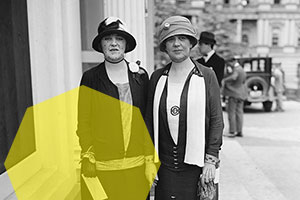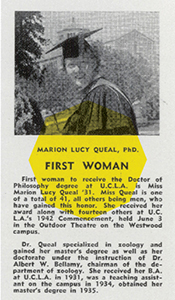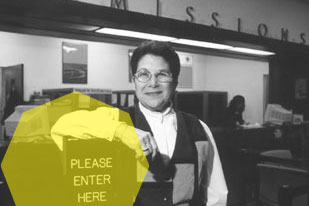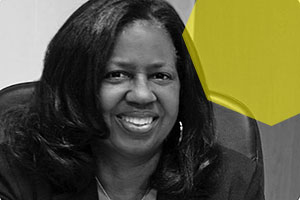 |
|
See the Women's Herstory Calendar Since UCLA’s inception, women have been pillars of inspiration uplifting students, staff and faculty alike. Women such as Nadine Crump who led the charge for UC education in Southern California as the director of Southern Extension in 1917, a two-year program created by UC Berkeley that would later develop into UCLA. And women like UC Regent Margaret Sartori, who voted in 1923 to add a third year to Southern Extension, helped cut the strings from UC Berkeley and drive towards an independent UCLA. In honor of Women’s History Month and the women who helped build UCLA – only to shatter several glass ceilings – here is a sampling of the nearly 100 years of influential Bruin women. 
As a growing institution, Bruin women were instrumental to campus life and the structure of the university. During the economic struggle of the Great Depression, Dean of Women Helen Matthewson Laughlin (right) helped women students find employment as well as housing in co-ops which allowed them to continue their studies on campus. Similarly Almira “Mira” Hershey’s $300,000 donation built the first and all-women’s residence hall on the Westwood campus still known as Hershey Hall. Thelma Gibson ’25 engraved her name in the annals of UCLA history when she wrote the words: “We’ll all be graduating soon. We really need some kind of organization to bind us together,” and became one of the founders of the UCLA Alumni Association. The Alumni Association currently is a network of more than 500,000 members and is the central thread that seams together True Bruins across the globe. Need proof? Just watch. As time passed, Bruin women banded together to make significant and lasting contributions to UCLA history. Gold Shield, an alumnae organization founded in 1936, was originally created as a financial support structure for Alumni Association student scholarships but has grown well beyond the boundaries of the 12 pioneering sisters. Gold Shield originated many successful programs like Dinners for 12 Strangers, and donated to help the construction of the John R. Wooden Center, Pauley Pavilion and the James West Alumni Center. The group presently has more than 150 members “who have contributed more than one million dollars to the UCLA Alumni Scholarship Program” and also awards the prestigious Gold Shield Faculty Prize for academic excellence. Gold Shield was and continues to be a UCLA cornerstone, as evidenced by winning the 2016 UCLA Award for Network of the Year. 
As UCLA staked its ground as a respected academic institution, the women of the university refused to be on the sidelines. In 1942, Bruin women broke into the world of academia when Marion Lucy Queal became the first woman to receive a doctorate from the college. Queal earned her B.A. in 1931, M.A. in 1935 and finally a Ph.D. in zoology in 1942 to impressively become a Bruin three times over. The 1940s also proved a pivotal decade for women’s equality on campus. As men were being drafted to serve in World War II, a vacuum formed on campus and women stepped into significant roles and positions of power – many positions previously off limits to women. In 1943, Josephine Rosenfield became the first woman editor of the California Daily Bruin and Associated Students Vice President Jo Anne Hollister boldly took over the position as president of Associated Students UCLA. Although the fight for women’s equality was a steep uphill battle, Rosenfield and Hollister persevered and climbed higher. Flora Lewis ’41 perfectly captured the tenacity of the 1940s women’s movement on campus when she wrote: “The day will surely come when women will be occupying positions previously stamped ‘Reserved for Men’ in factories, offices and perhaps even fields. When the work is done and the men come back, they will once again be chagrined to find their [indispensability] has been challenged.” Lewis would act as a stalwart for future Bruin women like Rae Lee Siporin. 
As the admissions director during the ’80s and ’90s, Siporin opened the academic door for nearly 250,000 students, revolutionized the university admission process and ultimately reshaped the UCLA student body. In her administrative role, Siporin created a more holistic application review process that took into account an applicant’s social and economic conditions such as being a first-generation student or being from a single-parent family. Siporin’s new and radical method undoubtedly created a more inclusive UCLA. Siporin not only transformed the university’s entire admissions process – a monumental feat in itself – she was also the co-founder of the UCLA Lesbian Gay Bisexual Transgender Faculty & Staff Network. The group “supports and promotes the interests and concerns of lesbian, gay, bisexual and transgender faculty and staff of the UCLA community by social, educational and political means.” Siporin was such a beloved Bruin and influential figure on campus, the Alumni Association created the Rae Lee Siporin Scholarship Fund and the UCLA LGBTQ Resource Center named a library in her honor. 
An ambassador of UCLA, Yolanda J. Gorman ’78, M.B.A. ’83, Ph.D. ’93 is a model of successful and impactful women Bruins. Currently, Gorman is the president of Phillips Graduate Institute in the San Fernando Valley and has extensive experience with organizational consulting in the nonprofit sector. Prior to her role at Phillips, she secured more than $100 million “from state, federal and private sources to help her clients develop and deliver programs that respond to critical human needs.” As a prominent figure beyond Westwood, Gorman continues to donate her time to the university. She is a current UC regent, for a second time, and was the first African American woman to serve as the chair of the UCLA Alumni Association board. Today women continually shape and redefine what UCLA is and will be. Women are championing UCLA, leading as students, professors, coaches, deans, vice provosts and vice chancellors. These are the women who are currently writing their names in the history books; these are the women who are making history now. With a long history of leadership and empowerment at UCLA, women are in the best position to tackle the difficult challenges that they face in society, with the determination of creating more opportunities and equality for the next generation of Bruin women. The question then becomes: how will they change the world? |
|
|